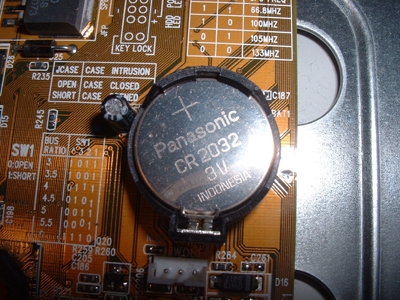If you are not sure of the location of the clear CMOS jumper, or your
system does not have one, there's another easy (but slower) way to clear the
CMOS memory and reset the BIOS. Every motherboard has a battery built in
which provides the trickle of power the CMOS memory needs to store
its information. If you remove the battery for a brief period, the CMOS should
lose its stored data.
In all modern motherboards, the battery is a standard CR 2032 Lithium Cell,
which looks like this:

To clear the CMOS memory, power down you system and remove this battery (you
will probably need a flathead screwdriver to do it) for 5-10 minutes, then pop
it back in and turn your system on. You will be prompted to set the BIOS
defaults. From the BIOS screen, save and exit, and the password should no
longer be set.
While this works well with desktop PCs, notebooks and
laptops employ slightly different methods of storing the BIOS password. In most
cases, like 99% of the time, you will not be able to reset a forgotten BIOS
password by this, or any other user accessible method. Since notebooks
are easily stolen, manufacturers have evolved their security measures significantly to help you protect your data, and
investment. Look for PCstats Guide to preventing data theft from a stolen laptop soon...
In the mean time, when it comes to resetting a BIOS-level password on a notebook, usually
the only option available is to send the entire notebook back to the
manufacturer for support.
Revealing disguised passwords in Windows
XP
With the way that Windows handles non-user account passwords -
such as dial in passwords for your Internet service provider, email access passwords
or website authorization boxes - it can be very easy to forget the
original password that you entered in long ago.
If you
have set autocomplete to fill in your password entries in Internet Explorer, for
example, you may have only entered each password once, many months ago,
no matter how many times you've used them.
Writing
all your passwords down for safekeeping is definitely recommended, but how can
you when they're all displayed as ***** in Windows?
Well, the
solution to this lies in third-party software that can peel back that row
of asterisks. There are many freely available software tools for decoding, or
revealing passwords in Windows or Internet Explorer dialog boxes.

